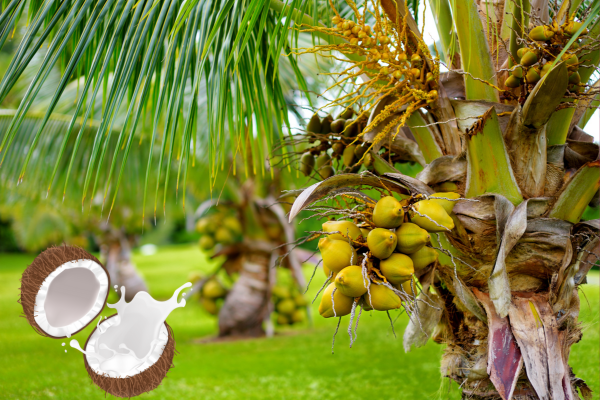The Coconut Tree: History, Health Benefits, and Uses – By Nadeeka – eLanka

History of the Coconut Tree
The coconut tree (Cocos nucifera) is often called the “Tree of Life” due to its extensive utility, which has been recognized for thousands of years. The exact origin of the coconut is still a subject of debate among historians and botanists. However, it is generally believed that the coconut originated in the region spanning from Southeast Asia to the Pacific Islands. Fossil records suggest that coconuts have been around for over 15 million years.
The coconut spread across the world through natural means—coconuts can float and are resistant to saltwater, allowing them to travel across oceans—and human migration. Early explorers and traders took coconuts with them, planting them in coastal regions. By the time Europeans arrived in the tropics, coconuts were already a staple in the diets and cultures of many indigenous populations.
Health Benefits of Coconuts
Coconuts offer a range of health benefits, making them a valuable addition to the diet:
- Nutrient-Rich: Coconuts are packed with essential nutrients, including vitamins C, E, B1, B3, B5, and B6, as well as minerals like iron, selenium, sodium, calcium, magnesium, and phosphorous.
- Hydration: Coconut water is an excellent source of hydration, rich in electrolytes like potassium, sodium, and magnesium. It is often used as a natural rehydration drink.
- Antioxidant Properties: The oil and water from coconuts contain antioxidants that help combat oxidative stress and reduce inflammation in the body.
- Heart Health: Although coconut oil contains saturated fats, they are mostly medium-chain triglycerides (MCTs), which may improve cholesterol levels and support heart health when consumed in moderation.
- Digestive Health: Coconut meat is high in dietary fiber, which aids digestion and promotes a healthy gut.
- Antimicrobial Effects: Lauric acid, found in coconut oil, has antimicrobial properties that can help protect against harmful bacteria, viruses, and fungi.
Uses of the Coconut Tree
The versatility of the coconut tree is unmatched, with virtually every part of the tree being used:
- Coconut Water: Extracted from young, green coconuts, it is consumed as a refreshing drink and used in cooking.
- Coconut Milk and Cream: Made from the grated meat of mature coconuts, these products are staples in many culinary traditions, especially in Asian and Caribbean cuisines.
- Coconut Oil: Used in cooking, skincare, and hair care. It’s also employed in traditional medicine and as a carrier oil in aromatherapy.
- Coconut Meat: Eaten fresh or dried, it can be used in desserts, curries, and snacks. Desiccated coconut and coconut flakes are common baking ingredients.
- Coconut Shells: Used as bowls, in handicrafts, and as a source of activated charcoal.
- Coconut Coir: The fibrous husk is used for making ropes, mats, brushes, and as a growing medium in horticulture.
- Coconut Leaves: Employed in thatching roofs, making baskets, and creating eco-friendly packaging.
- Coconut Timber: The wood from older trees is used in construction and furniture making.
Why the Coconut Tree is Helpful to People
The coconut tree’s myriad benefits make it an invaluable resource for many communities:
- Economic Value: Coconuts are a significant source of income for farmers in tropical regions. The various products derived from the tree support local economies and international trade.
- Nutritional Support: In many parts of the world, coconuts are a crucial source of nutrition, providing essential vitamins and minerals that might otherwise be lacking in the diet.
- Sustainability: Coconut trees are highly sustainable. They require minimal care, can grow in poor soil, and provide a renewable source of food and materials.
- Cultural Significance: The coconut tree holds cultural importance in many tropical societies, featuring prominently in religious rituals, traditional medicine, and folklore.
- Environmental Benefits: Coconut trees help in stabilizing coastal areas and preventing soil erosion. They also contribute to the biodiversity of tropical ecosystems.
Easy Coconut Pudding Recipe
Coconut pudding is a creamy, delightful dessert that is simple to make and sure to please. Here’s a straightforward recipe for a rich and smooth coconut pudding.
Ingredients:
- 2 cups coconut milk (full-fat for a richer pudding)
- 1/4 cup sugar (adjust to taste)
- 1/4 cup cornstarch
- 1/8 teaspoon salt
- 1 teaspoon vanilla extract
- Optional: toasted coconut flakes for garnish
Instructions:
- Mix Dry Ingredients: In a medium saucepan, whisk together the sugar, cornstarch, and salt until well combined.
- Add Coconut Milk: Gradually whisk in the coconut milk, making sure there are no lumps.
- Cook the Pudding: Place the saucepan over medium heat. Cook the mixture, stirring constantly, until it thickens and comes to a gentle boil. This should take about 5-7 minutes. Continue to cook for an additional 1-2 minutes while stirring, until the pudding is thick and smooth.
- Add Vanilla: Remove the saucepan from the heat and stir in the vanilla extract.
- Cool the Pudding: Pour the pudding into individual serving dishes or a large bowl. Cover the surface of the pudding with plastic wrap to prevent a skin from forming. Let it cool at room temperature for about 15 minutes, then refrigerate for at least 2 hours, or until fully chilled.
- Garnish and Serve: Before serving, you can sprinkle toasted coconut flakes on top for an added crunch and extra coconut flavor.
Tips:
- For a more decadent pudding, substitute part of the coconut milk with heavy cream.
- Adjust the sweetness to your preference by adding more or less sugar.
- For a tropical twist, add a splash of coconut rum or a few drops of coconut extract along with the vanilla extract.
Enjoy your homemade coconut pudding, a perfect dessert for any occasion!







